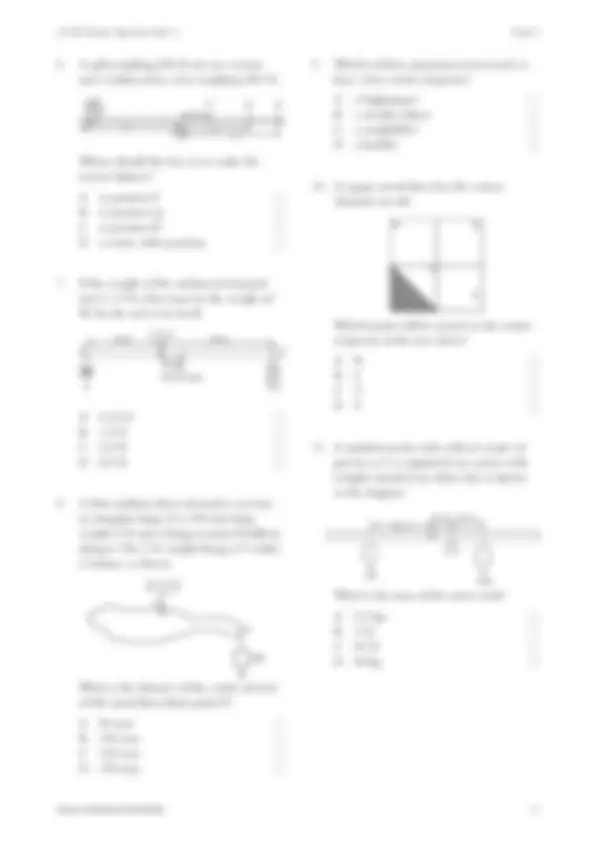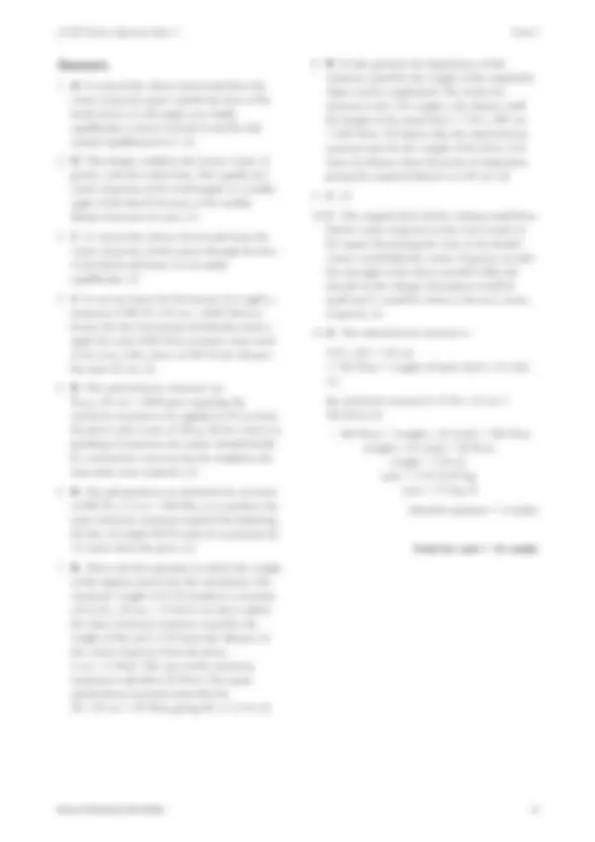




Study with the several resources on Docsity

Earn points by helping other students or get them with a premium plan


Prepare for your exams
Study with the several resources on Docsity

Earn points to download
Earn points by helping other students or get them with a premium plan
Community
Ask the community for help and clear up your study doubts
Discover the best universities in your country according to Docsity users
Free resources
Download our free guides on studying techniques, anxiety management strategies, and thesis advice from Docsity tutors
The Principle of Moments says that: In equilibrium (or 'balance'). The total anticlockwise moment = The total clockwise moment. Centre of gravity.
Typology: Study Guides, Projects, Research
1 / 4

This page cannot be seen from the preview
Don't miss anything!



The centre of gravity of an object is the point through which the whole weight of the object seems to act.
A metre stick supported above its centre of gravity will be level – in equilibrium; but if it is held somewhere else it will be unstable and tip over.
The object A will keep upright – be in stable equilibrium when its centre of gravity acts downwards through its base. But if is tipped over too far, the centre of gravity acts outside its base ( B ) and it topples over; it was tipped into a position of unstable equilibrium.
A ball resting on a horizontal surface is always in neutral equilibrium , because its centre of gravity always acts through its base, the point at which it touches the surface.
The turning effect of a force is called a MOMENT. If we open a door, steer a car or use a spanner we are employing the turning effect of a force.
The MOMENT of a force = FORCE x DISTANCE ( Nm ) ( N ) ( m )
The distance is measured from the point where the force is acting to the pivot.
The Principle of Moments says that: In equilibrium (or ‘balance’)
The total anticlockwise moment = The total clockwise moment.
Centre of gravity Centre of gravity In equilibrium Unstable
A B
Weight (w) (N)
Distance (D) (m)
Moment (Nm)
Weight (W) (N)
Distance (d) (m)
Moment (Nm) 300 0.55 165 500 0.33 165
Pivot
Force applied
Clockwise moment
Distance
D
���� ��
� 300 N w W 500 N
d 0.55 m 0.33 m A B
Anticlockwise Clockwise
Tick the box next to the correct answer.
a bottle. Which bottle is in a position of unstable equilibrium?
2 Four lorries have their centres of gravity
the most stable?
3 A block of wood with the centre of
block:
A will topple over to the left ■ B will topple over to the right ■ C will remain upright ■ D is said to be in unstable ■ equilibrium
4 When the forcemeter A was used on its own on the spanner to loosen a nut it read 200 N. Forcemeter B was then used on its own to loosen the nut and it read 300 N.
What was the distance X in the diagram? A 10 cm ■ B 15 cm ■ C 20 cm ■ D 25 cm ■
5 The diagram shows a metre stick pivoted at its centre.
The metre stick will balance when the mass M is: A 100 g ■ B 120 g ■ C 150 g ■ D 180 g ■
A B C D
A B C D
30 cm
200 N 300 N A B
0 10 20 30 40 50 60 70 80 90 100
90 g
M
1 D A vertical line drawn downward from the centre of gravity passes outside the base of the bottle, hence it will topple over. Stable equilibrium is shown in both A and B, with neutral equilibrium in C. (1)
2 D This design combines the lowest centre of gravity with the widest base. The equally low centre of gravity in B would topple at a smaller angle of tilt than D because of the smaller distance between its tyres. (1)
3 C A vertical line drawn downwards from the centre of gravity clearly passes through the base of the block and hence it is in stable equilibrium. (1)
4 C It was necessary for forcemeter A to apply a moment of 200 N x 30 cm = 6000 Ncm to loosen the nut. Forcemeter B therefore had to apply the same 6000 Ncm moment when used on its own; with a force of 300 N, the distance becomes 20 cm. (1)
5 B The anticlockwise moment was 90 g x 40 cm = 3600 gcm requiring the clockwise moment to be applied at 30 cm from the pivot with a mass of 120 g. (To be correct in speaking of moments, the masses should ideally be converted to newtons but for simplicity the mass units were retained.) (1)
6 B The girl produces an anticlockwise moment of 200 N x 1.5 m = 300 Nm, so to produce the same clockwise moment required for balancing, the boy of weight 300 N must sit at position Q, 1.0 metre from the pivot. (1)
7 B This is the first question in which the weight of the support enters into the calculation. The clockwise weight of 0.5 N produces a moment of 0.5 N x 30 cm = 15 Ncm. To this is added the (also) clockwise moment caused by the weight of the rod, 1.0 N times the distance of the centre of gravity from the pivot, 5 cm = 5 Ncm. The sum of the clockwise moments is therefore 20 Ncm. The equal anticlockwise moment must then be W x 20 cm = 20 Ncm giving W as 1.0 N. (2)
8 B In this question the importance of the moment caused by the weight of the suspended object itself is emphasised. The clockwise moment is the 3 N weight x the distance, half the length of the metal sheet = 3 N x 200 cm = 600 Ncm. To balance this, the anticlockwise moment must be the weight of the sheet, 5 N, times its distance from the point of suspension, giving the required distance as 120 cm. (2) 9 C (1) 10 C The original sheet before cutting would have had its centre of gravity in the exact centre of the square. Removing the mass at the shaded corner would shift the centre of gravity towards the top right of the sheet, towards S. But the amount of the change of position would be small and T would be closer to the new centre of gravity. (1) 11 A The anticlockwise moment is 4 N x (30 + 10) cm = 160 Ncm + weight of metre stick x 10 (cm) (1) the clockwise moment is 12 N x 15 cm = 180 Ncm (1) ∴ 160 Ncm + [weight x 10 (cm)] = 180 Ncm [weight x 10 (cm)] = 20 Ncm weight = 2 N (1) mass = 2 N/10 N/kg mass = 0.2 kg (1) (Total for question = 4 marks)
Total for unit = 16 marks